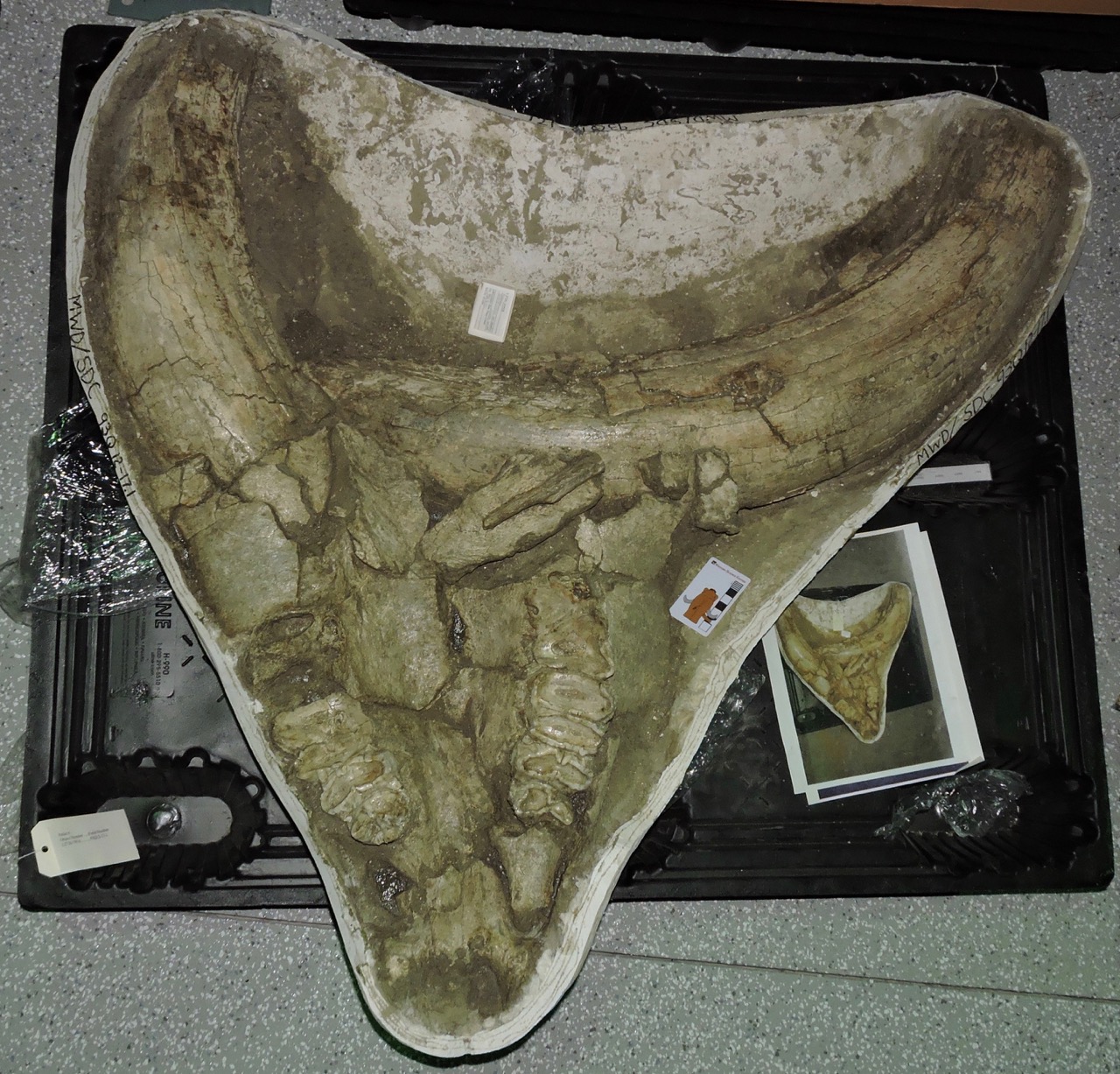 Our latest mastodon installment as we approach the "Valley of the Mastodons" exhibit opening 3 weeks from now is "Braces", a partial mastodon skull from the San Diego Canal."Braces" is still in his field jacket, with the ventral side exposed (and the large tusks do indicate that he's male). Below is an annotated version:
Our latest mastodon installment as we approach the "Valley of the Mastodons" exhibit opening 3 weeks from now is "Braces", a partial mastodon skull from the San Diego Canal."Braces" is still in his field jacket, with the ventral side exposed (and the large tusks do indicate that he's male). Below is an annotated version: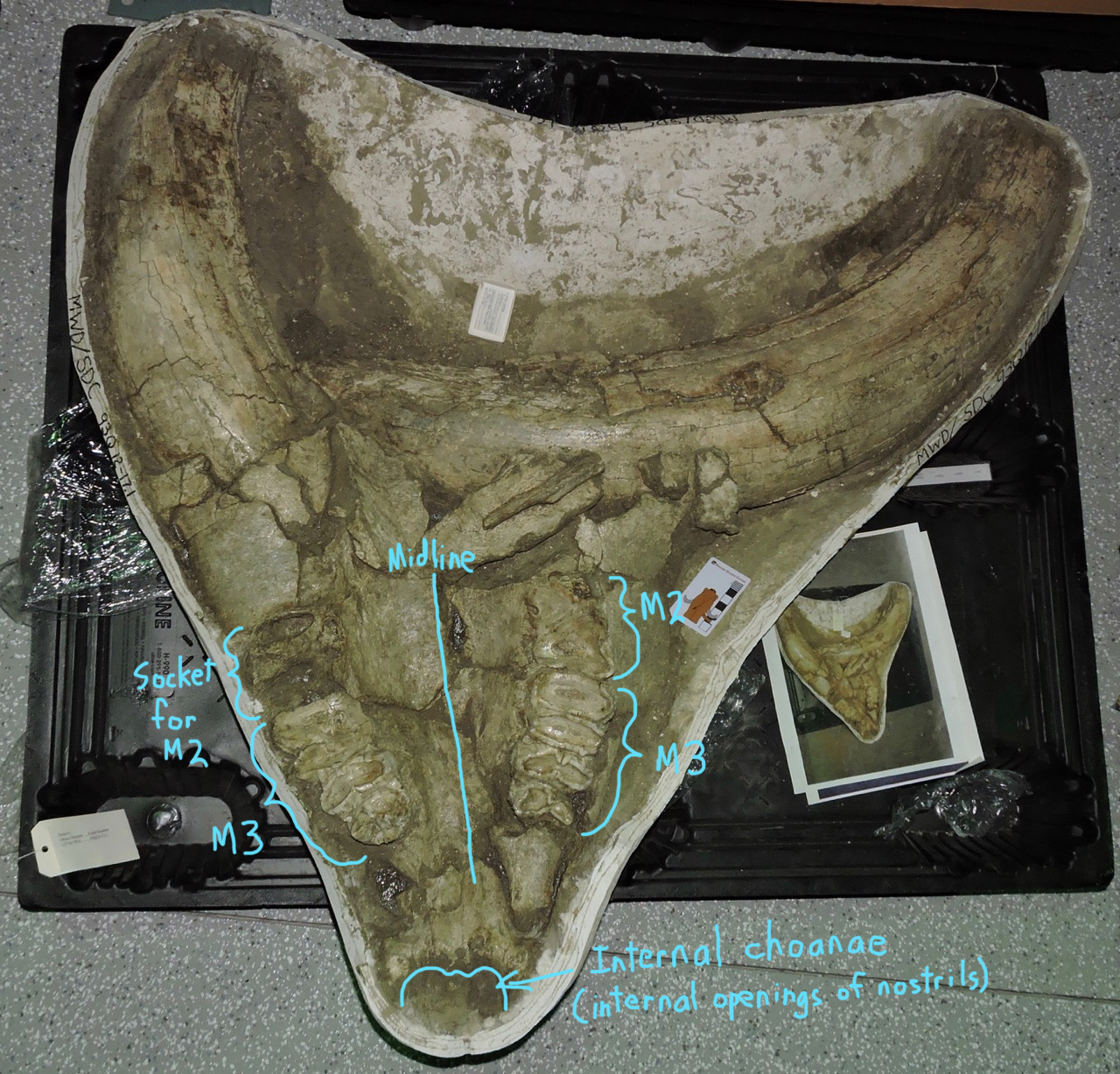 "Braces" was a fully mature mastodon, roughly 40 years old based on tooth wear. The right 2nd molar is missing, and I'm pretty sure it had fallen out well before the mastodon died. It looks like the socket had started closing up, and the corresponding left second molar was worn all the way down to the bone.Braces' name comes from anomalies in the wear pattern on his teeth. Typically, proboscidean teeth wear in a fairly predictable way. The upper teeth wear more rapidly along the interior half of the occlusal surface (the lingual, or tongue-ward, side), while lower teeth wear more rapidly along the exterior half (the labial, or lip-ward, side). This may seem a little confusing, but it just means that when the upper and lower teeth occlude they do so along an angled surface, as shown in this schematic drawing of a cross-section through a mouth:
"Braces" was a fully mature mastodon, roughly 40 years old based on tooth wear. The right 2nd molar is missing, and I'm pretty sure it had fallen out well before the mastodon died. It looks like the socket had started closing up, and the corresponding left second molar was worn all the way down to the bone.Braces' name comes from anomalies in the wear pattern on his teeth. Typically, proboscidean teeth wear in a fairly predictable way. The upper teeth wear more rapidly along the interior half of the occlusal surface (the lingual, or tongue-ward, side), while lower teeth wear more rapidly along the exterior half (the labial, or lip-ward, side). This may seem a little confusing, but it just means that when the upper and lower teeth occlude they do so along an angled surface, as shown in this schematic drawing of a cross-section through a mouth: 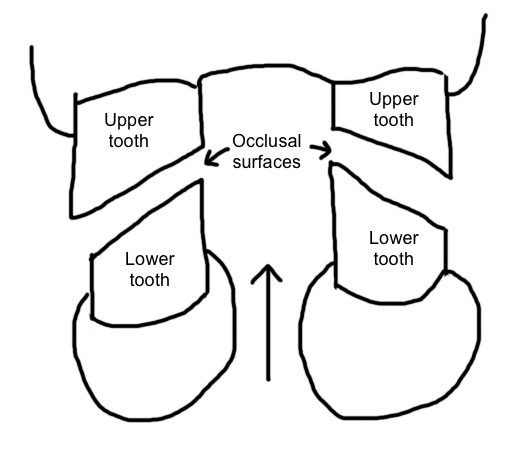 Here's a closeup of Braces' right 3rd molar, followed by an annotated version:
Here's a closeup of Braces' right 3rd molar, followed by an annotated version: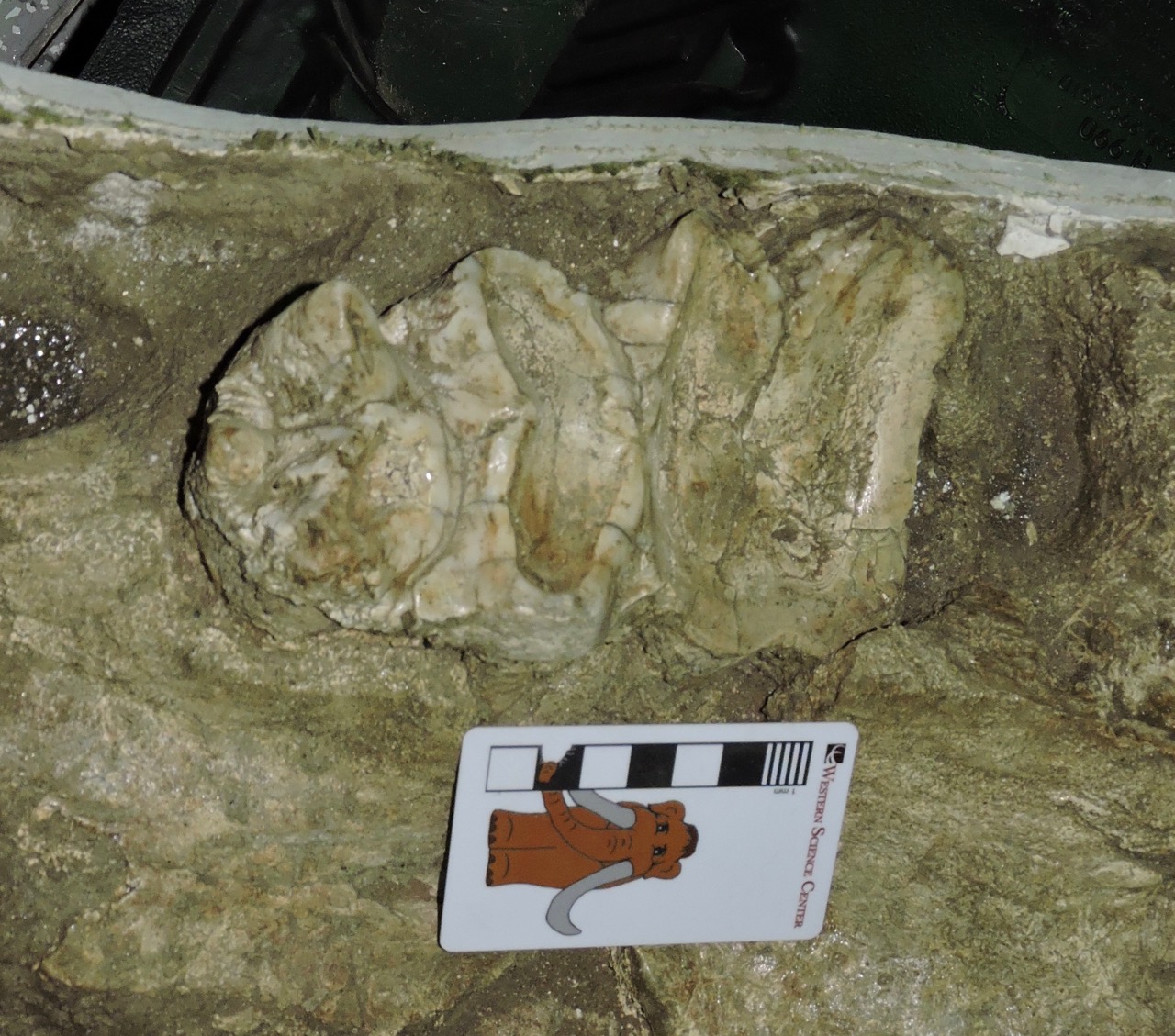
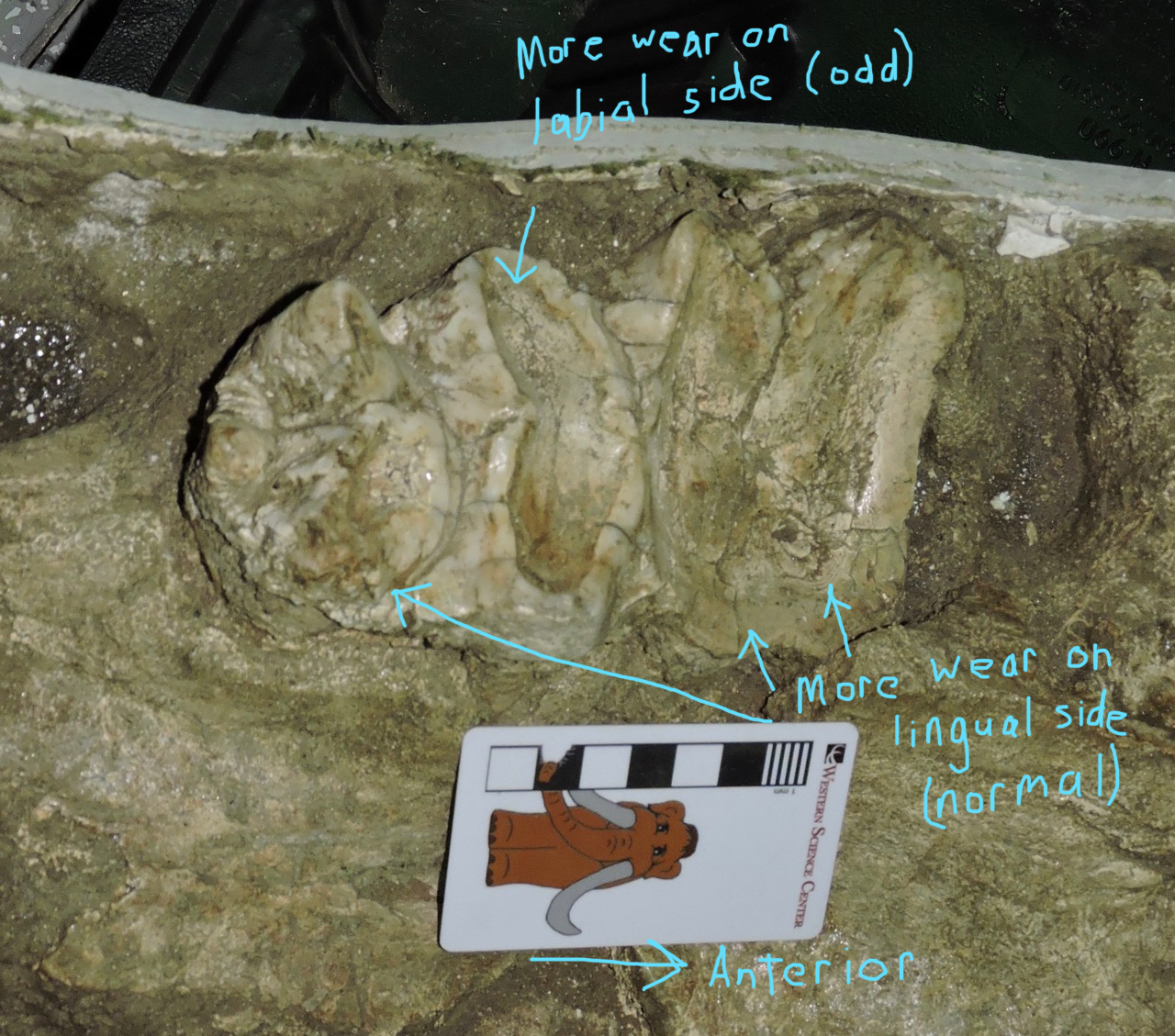 In Braces, the upper 3rd molar starts off wearing just as it should, with much heavier wear on the lingual side. But then, on the third loph, the wear pattern reverses, with heavier wear on the labial side like you would expect to see in a lower tooth. Then, on the fourth loph, the wear switches back to the normal pattern with heavier wear on the lingual side.It seems that there was some anomaly with the way Braces' teeth were aligned and occluding with each other. I'm not sure what caused this. Unfortunately we don't have the lower jaw, which might help. Maybe he had an injury to his lower jaw that changed the way he closed his mouth? Certainly Max, who was a slightly younger animal, had several jaw injuries. Or maybe this has to do with the right 2nd molar being lost before the left on; perhaps that sets up an asymmetry in the chewing dynamics. If this is the case, it's possible that if Braces had lived longer the pattern would have reversed itself. Maybe this is a relatively common but temporary condition, that only occurs during the brief periods when the tooth count is different on each side of the jaw.Along with most of our other mastodons, Braces will be on display in our Valley of the Mastodons exhibit that opens on August 5.
In Braces, the upper 3rd molar starts off wearing just as it should, with much heavier wear on the lingual side. But then, on the third loph, the wear pattern reverses, with heavier wear on the labial side like you would expect to see in a lower tooth. Then, on the fourth loph, the wear switches back to the normal pattern with heavier wear on the lingual side.It seems that there was some anomaly with the way Braces' teeth were aligned and occluding with each other. I'm not sure what caused this. Unfortunately we don't have the lower jaw, which might help. Maybe he had an injury to his lower jaw that changed the way he closed his mouth? Certainly Max, who was a slightly younger animal, had several jaw injuries. Or maybe this has to do with the right 2nd molar being lost before the left on; perhaps that sets up an asymmetry in the chewing dynamics. If this is the case, it's possible that if Braces had lived longer the pattern would have reversed itself. Maybe this is a relatively common but temporary condition, that only occurs during the brief periods when the tooth count is different on each side of the jaw.Along with most of our other mastodons, Braces will be on display in our Valley of the Mastodons exhibit that opens on August 5.
